There’s no denying that the Riviera Maya, spanning from the popular beaches of Cancun down to Playa Del Carmen and all the way to the gorgeous white sands of Tulum, includes some of the best sand and ocean views in continental North America.
What you may not realize is the Riviera Maya and Mexico’s Yucatan peninsula itself also contain dense jungles and some of the best cenotes you’ll find anywhere in the world.
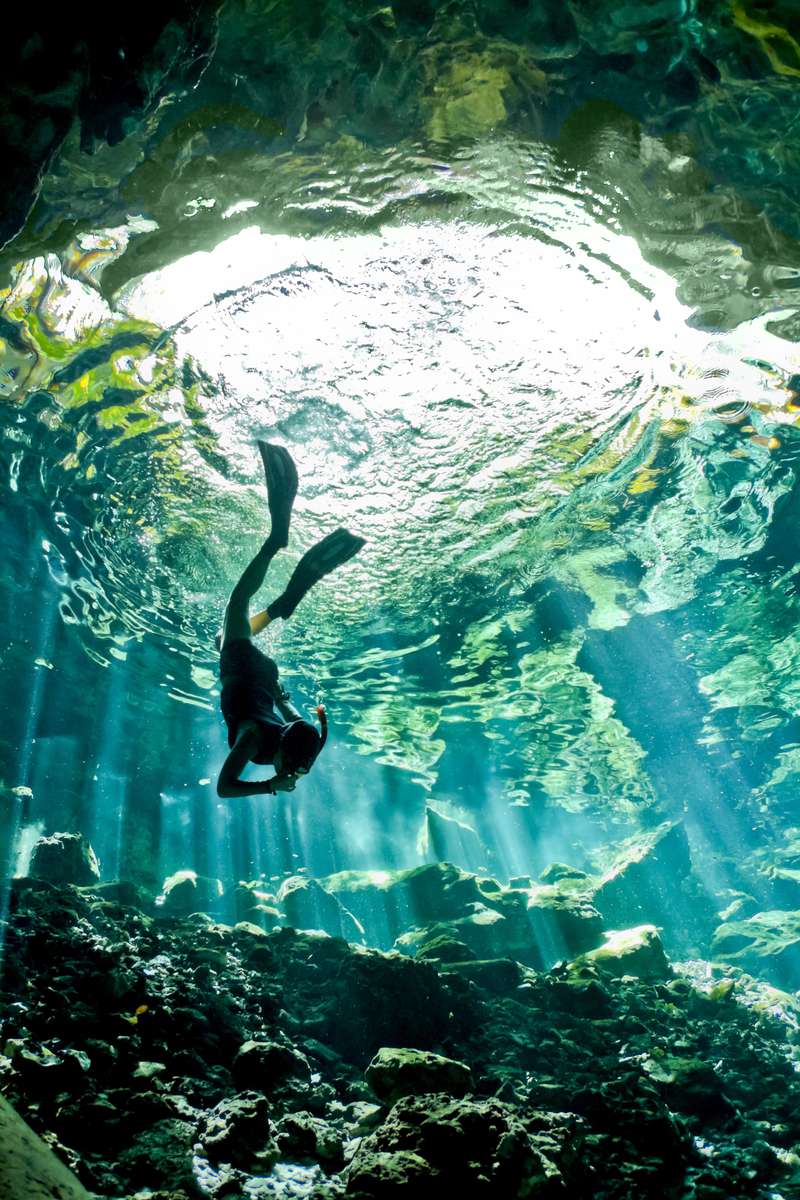
What’s a cenote?
Since limestone bedrock can be found all across the Mayan Riviera, over the years many of these areas of porous rock have formed into underground rivers. These freshwater underground rivers usually form caverns of crystal clear water as the limestone filters and purifies the water naturally.
Eventually, many of these caverns have collapsed and have opened themselves up to the sky, ready to be explored. These limestone sinkholes are called cenotes and there are literally thousands of them found across this Mexico region, with new ones still being found today in the Riviera Maya.
What this means for you, is that no matter where you go in the Mayan Riviera, you’ll likely find one of these inviting cenotes to spend your day. Whether you’re there just to swim, jump off the surrounding cliffs or even there to go snorkelling and scuba diving in, cenotes offer a great way to explore the Riviera Maya’s hidden world away from the beach.
Coming from the Mayan word “dzonot” or “tsonot,” which essentially translates to “well” in English, cenotes (pronounced “say-no-tays”) also hold a historical value to the region. The ancient Mayans realized that these large wells could supply enough freshwater to sustain entire villages and even larger ancient cities like Chichen Itza relied on cenotes to survive.
Some of these pools were considered sacred and everything from gold to jade to gorgeous mother of pearl jewelry have been found over the years including the bones from ancient sacrifices the Mayans did to procure a bountiful season. While the sacred pools remain closed and have been preserved, the rest of the Riviera Maya’s cenotes are open for visitors.
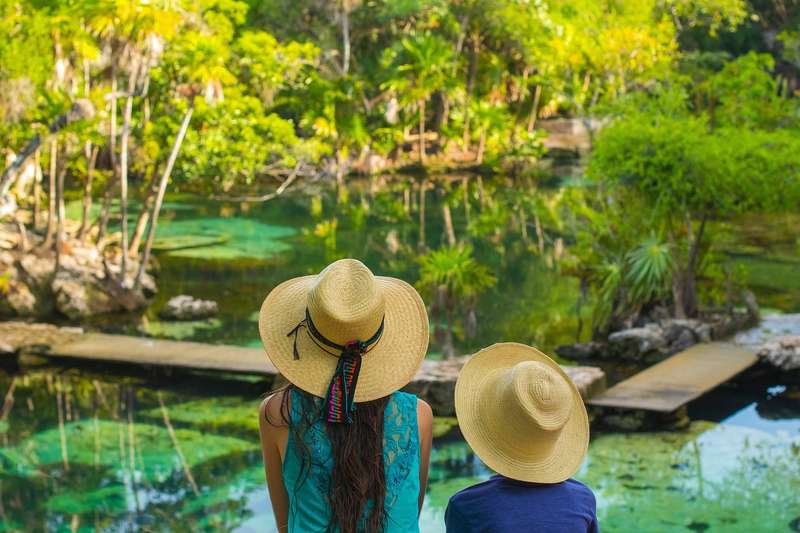
Types of Cenotes in Riviera Maya
There are essentially four types of cenotes found in Riviera Maya. This includes open air cenotes, semi-open cenotes, cave or semi-closed cenotes and underground cenotes.
Open air cenotes tend to resemble small ponds or lakes with the vast majority of the water easily accessible. Though they can often have steep sides, they’re fairly common to find and offer ease of access vs the other cenote styles. These are best for families as everything is within site and access to the water is usually the easiest.
Semi-open cenotes are cenotes with rocky overhangs. Often a good portion of the cenote is considered open air with corners that are partially blocked from the sky. They tend to feature darker areas that are fun to explore with snorkeling gear. Generally they’re fine for families as well.
Cave cenotes are typically cenotes with a small hole leading to the sky. It is often darker while swimming here and you often need to take a ladder to get down to the water itself. Not recommended for smaller children, they probably feature some of the best high diving you’ll find if you’re an adventure seeker.
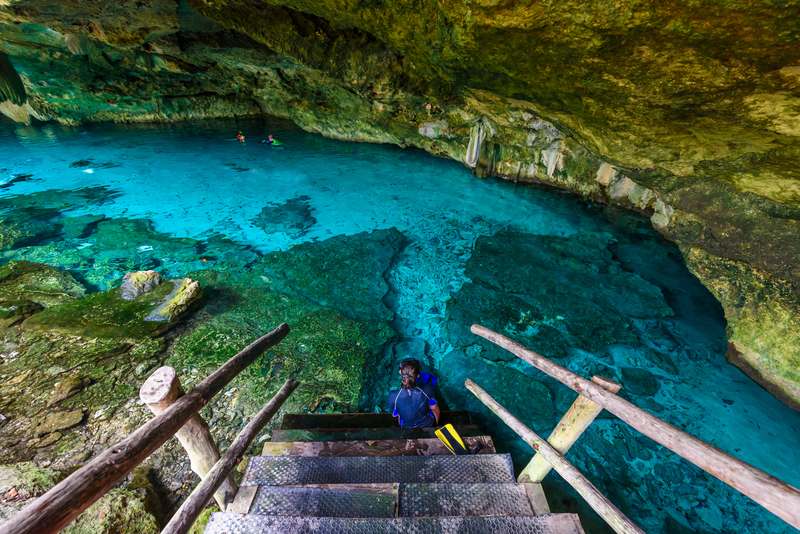
Underground cenotes are exactly as they sound. These flooded cenotes are closed off from above and can only be explored by scuba diving and usually only with a knowledgeable guide. Also only recommended for expert cavers.
Why visit a cenote in Riviera Maya?
While sun and sand make for a great vacation, sometimes it’s nice to check out something new. With cenotes found near most of the major areas in Mexico’s Riviera Maya, getting to one often only takes a short trip. Some are also adjacent to popular archive sites or make a great stop when visiting other areas of the peninsula.
So, if exploring crystal clear, freshwater pools in a naturally formed limestone setting sounds like a perfect day away from the salt and sand of the Mayan Riviera (it really is), read on as we take a look at the best cenotes in Riviera Maya.
Cenote Cristalino
Cenote Cristalino is one of the first cenotes our family ever explored in Mexico’s Yucatan peninsula. Interestingly, Cenote Cristalino is also one of the first cenote posts we ever wrote on this site back in 2010 so it still holds a special place in our hearts.
Just a stones throw away from Playa Del Carmen (10 km south of Playacar proper) and an easy taxi ride to get there, it’s not as popular as some of the bigger cenotes on this list however we’ve always enjoyed the times we’ve visited it. Almost across the road from Barcelo Maya Beach All Inclusive, it’s few open clear water pools complete with nibbling minnows make it an inviting cenote to visit.
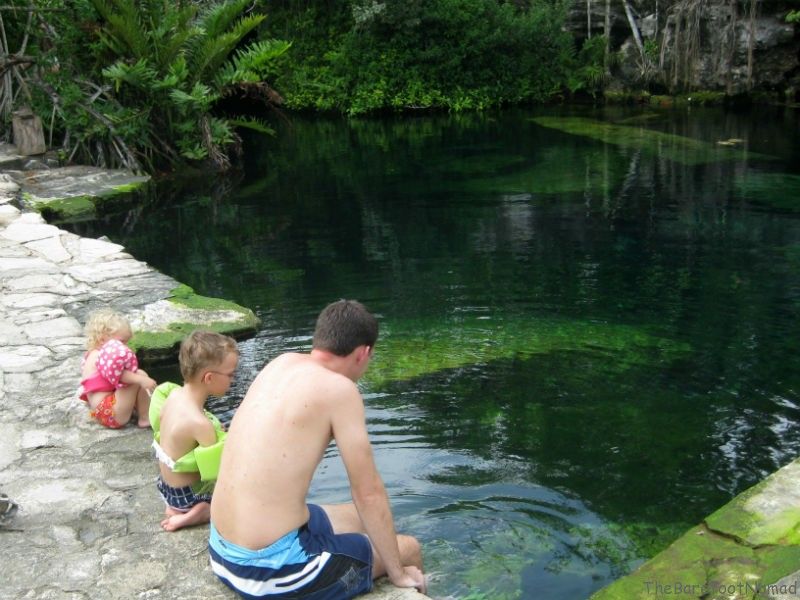
It’s also less touristy than many of this list as the area is less developed. The last time we were there a few years ago, it also hadn’t been bought out by a bigger company so it still maintains a rustic charm. You can find a place to buy snacks and changing rooms exist on site. There’s a small daily fee to get in.
Cenote Azul
Cenote Azul is a nice open cenote that appeals to families and those looking for a relaxing day out. Its shallow areas are perfect for children, while deeper sections satisfy snorkelers and those wanting to swim a few laps. The surrounding rock formations offer spots to jump from for the more adventurous visitors.
Walking distance from Cenote Cristalino, it offers more services such as showers and restrooms. There is a small fee to use the services there however it’s only a 10 minute ride from Playa Del Carmen so makes for an easy getaway if you’re staying in the region.
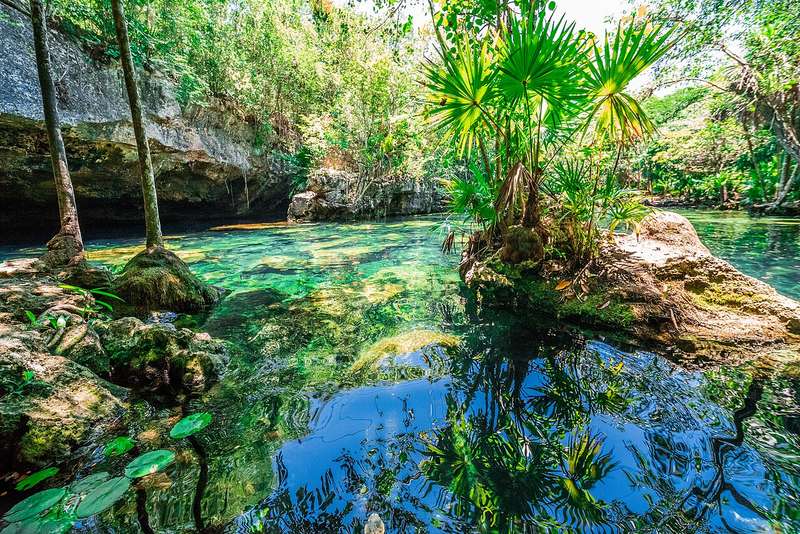
Cenote Dos Ojos
One of the most famous cenotes in the Yucatan Peninsula, Cenote Dos Ojos, or “Two Eyes Cenote,” boasts two connected sinkholes resembling a pair of eyes. Its crystal-clear waters and extensive underwater cave system make it a paradise for snorkelers and especially divers as it features an fairly extensive labyrinth of flooded caves to explore. The light filtering through the openings also creates a magical atmosphere, perfect for underwater photography.
The day we went to Cenote Dos Ojos, we saw many more divers than swimmers. Since the water in this luminescent blue cenote can be quite deep, it’s definitely not geared towards younger families though ours were fine with the lifejackets we brought that day and the cave portion is quite cool to see.
Geared more towards divers that swimmers, there are changing rooms, bathrooms, lockers for rent and even a restaurant on site. Cenote Dos Ojos can be found approximately 22km (13 miles) north of Tulum on Carretera 307.
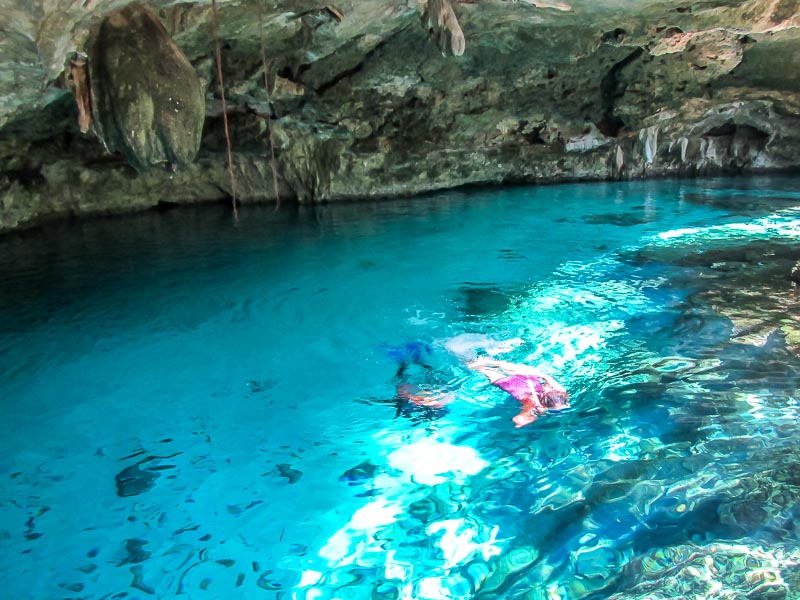
Gran Cenote
A short 10 min drive from Tulum proper up QROO 109, Gran Cenote is a semi-open cenote surrounded by lush vegetation. Its clear, turquoise waters are home to turtles and small fish, making it an excellent spot for snorkeling. Numerous wooden platforms and stairs provide easy access for swimming and soaking up the serene beauty of this natural pool.
While it’s much quieter than Doj Ojos, Gran Cenote is a bit more friendly towards families and is a quick trip from Tulum. There are open caves you can easily swim into and lots of the cenote bottoms have sand you can stand on. While you can’t stay right by the water, you can spread out above the cenote area. As the name implies, Gran Cenote itself is quite large.
One of the biggest draws to Gran Cenote in Maya Riviera are the turtles and the short distance to Tulum. There are showers, bathrooms, lockers and even hammocks you can use. Day fees at Gran Cenote are around the 200 peso range.
Cenote Zacil Ha
Just down the road from Gran Cenote, Cenote Zacil Ha is another cenote favorite for those staying Tulum. Cenote Zacil Ha features a very open air feeling and even includes a small zipline you can use to get into the long pool.
Cenote Zacil Ha makes a great (and cheap) refreshing stop when returning from the popular Coba archeological site. At under 100 pesos, it features bathrooms and changing rooms.
Cenote Aktun-Ha
Another cenote close to Tulum and just a few hundred meters from Cenote Zacil Ha, Cenote Aktun-Ha (“water cave”) is a very large open air cenote in Riviera Maya. It also nicknamed Cenote Carwash as the local taxi drivers used to use the water to wash their vehicles.
With plenty of turtles and fish in the cenote, it has a maximum depth of around 18m or 60ft so you’ll see the occasional diver down below as well. There are restrooms, changing rooms and platforms you can use to access the water. It also features a 10ft (3M) diving platform
Cenote Ik Kil
Located near the very cool and popular Chichén Itzá, Cenote Ik Kil is an open-air cenote with dramatic vine-covered cliffs and cascading waterfalls. The circular shape of this cenote and the hanging roots reaching down towards the water surface create a mystical vibe.
It’s a popular spot, so consider visiting early in the morning to avoid crowds or stay for a few days at one of the cabins on site. Cenote Ik Kil includes bathrooms, change rooms and even has a restaurant on site. Prices are in 100 Peso range for adults and 50 Peso for children.
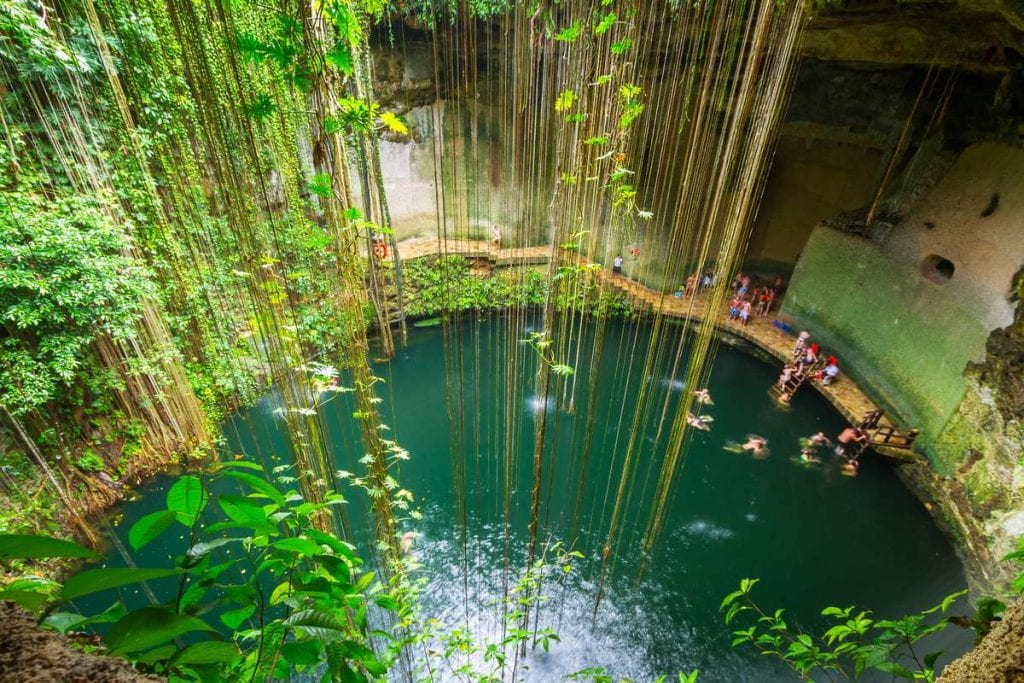
Cenote Zací
While not in Riviera Maya itself, located in the heart of Valladolid, Cenote Zací is a semi-open cenote that offers a convenient break from city exploration. Its massive open cave features a small island with lush vegetation in the center, and its waters are home to rare eyeless black fish. The on-site restaurant provides a unique dining experience with views of the cenote.
Located between Cancun and Chichen Itza, Cenote Zaci is also a great stop if you’re exploring the ruins that day and want to cool off before driving the rest of the way back to Cancun. Though the waters in this cenote aren’t the clearest, swimming in the giant cavern of Cenote Zaci is an unforgettable experience. It has bathrooms, changing rooms and a restaurant on site. Prices are around 60 pesos for adults and 30 pesos for children.
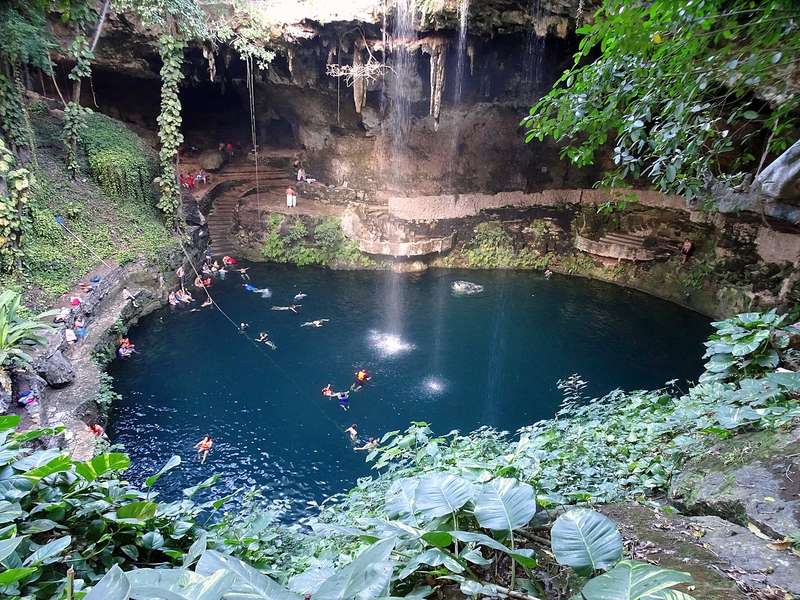
Cenote Escondido (Mayan Blue) and Cenote Cristal
Cenote Escondido, nicknamed Mayan Blue by the locals, and Cenote Cristal are both large, open-air cenotes close to Tulum. Both feature jungle settings as well as have cliff jumping (12ft or 4m) and a rope swing.
These 2 cenotes are both owned by the same company and are right next to each other. Both offer ample parking, toilets, showers and changing rooms. Each cenote costs 150 Pesos as an entry fee. If having to decide between one or the other, most people recommend Cenote Escondido over Cenote Cristal. With more area to explore, Cenote Escondido is bigger, and almost feels like you’re swimming in a river than a typical cenote.
Tips for Visiting Cenotes in Riviera Maya
- Bring Eco-Friendly Sunscreen: To protect the delicate ecosystem of the cenotes, use biodegradable sunscreen however note that many cenote owners strongly discourage any sunscreen at all to minimize the impact lotions have on the system.
- Wear Water Shoes: Many cenotes have rocky bottoms, so water shoes can help protect your feet.
- Bring Mask and Snorkel: While many sites offer snorkel rentals, the quality can be suspect and paying for each use can add up over time. Better to bring your own and, if space is tight in your bag, leave the flippers at home and just bring along your mask and snorkel.
- Respect the Environment: Keep the cenotes clean by not leaving any trash behind. Each cenote is a natural wonderland complete with a delicate ecosystem. Make sure to minimize your footprint when visiting.
- Check for Entrance Fees: Most cenotes charge an entrance fee, which is used for maintenance and preservation.
- Make sure you don’t get scammed: The most expensive cenotes charge up to 150 pesos for an adult but many charge only 50 or 60 per person.
- Leave valuables at home: Small theft around certain cenotes is a problem. Leave your valuables at the hotel or rent a locker on site if you have things you don’t want walking away.
- Extra costs for cameras and drones: A few companies have realized they can have an upcharge for people bringing in costly cameras and drones and have decided to charge extra for it. Depending on the cenote, the costs can equal the entrance fee. If you don’t need it, leave it behind.
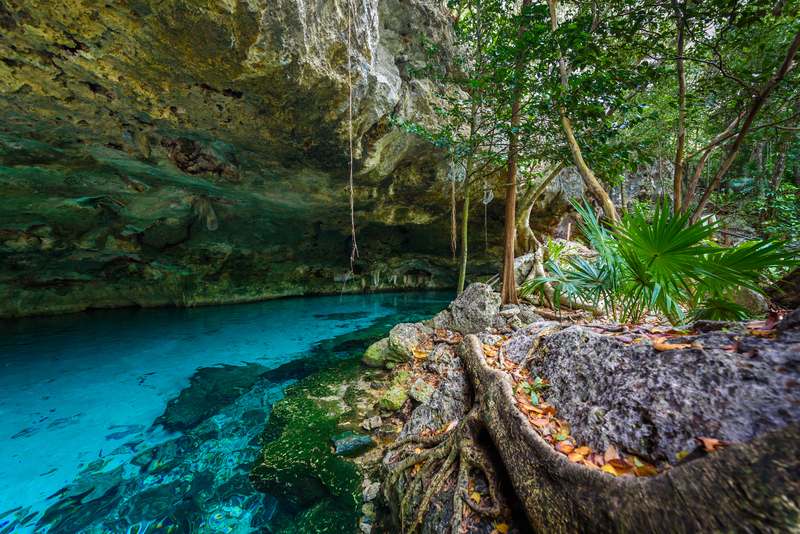
Whether you’re an avid cave diver, a snorkeling enthusiast, a cliff jumper or simply looking for a picturesque spot to relax, the cenotes of the Riviera Maya offer something for everyone. Each cenote has its unique charm, inviting visitors to explore the hidden treasures of the Yucatan’s underground world.
With something unique to see at each cenote, from stalactites and stalagmites to colorful turtles and even more colorful fish, you’ll never get a chance to experience such a large array of cenotes anywhere else on the planet.
We’ve written dozens of articles about Mexico over the years and often consider the Riviera Maya and Playa Del Carmen to be our second home.

